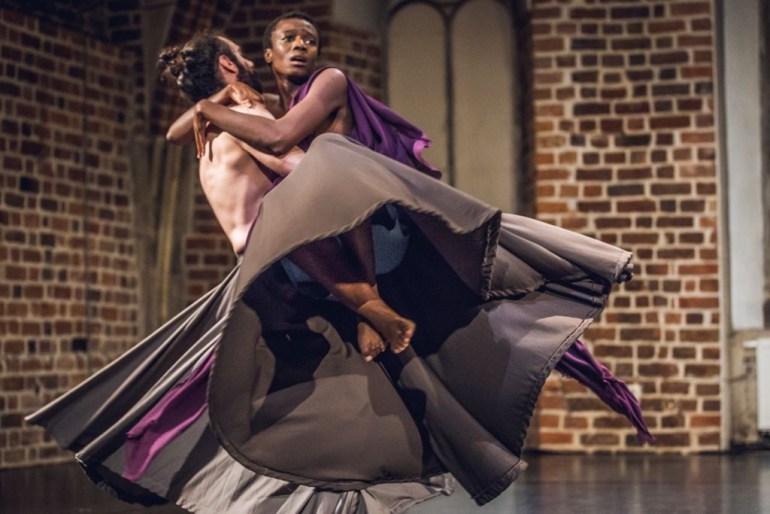Colette Dalal Tchantcho from Kuwait (she also has African roots) lives in Great Britain. As an actress, she was trying to look for ways to combine singing and dancing, but not in a manner typical of musical theatre. ‘I saw Song of Lear in Scotland and it was a strong, spiritual experience to me. Besides, Shakespeare fascinates me’.
Ifi Ude (born Diana Ifeoma Ude), a well-known Polish-Nigerian vocalist who has already debuted in film, has also been invited to join the group of seventeen artists. ‘Perhaps I am in Song of the Goat Theatre because I’m not afraid of risk in music. In the case of Crazy God it is important, because the differences between a vocalist, a musician, a dancer, or an actor blend – everyone goes outside the framework of their profession. It’s incredible that this way we’re able to discover new talents in ourselves. During rehearsals I found out I have a four-octave vocal range’.
 Crazy God, Song of the Goat Theatre, photo: Mateusz Bral
Crazy God, Song of the Goat Theatre, photo: Mateusz BralThe music for the spectacle was composed by Katarzyna Szwed, a young yet already highly appreciated composer of contemporary music. This is the first time she has cooperated with a theatre. ‘When I was creating music for Crazy God, I focused on making something massive. The choir is big, the chords – strong and dense. There is no place for weak or lukewarm moments’.
On stage, there are only violins, a vibraphone, drums, and the actors’ voices’. Adam Clifford, a drummer from Scotland, is the author of instrumental compositions and arrangement. In the play, texts written especially for this purpose and poetic collages inspired by Shakespeare’s Hamlet, the work HamletMachine by Heiner Müller, and Allen Ginsberg’s Howl will appear. The massive, heavy iron scenography was created by Professor Robert Florczak. The costumes were designed by Alicja Gruca.
 Crazy God, Song of the Goat Theatre, photo: Mateusz Bral
Crazy God, Song of the Goat Theatre, photo: Mateusz BralThe premiere took place on 1st July 2016 and inaugurated the Brave Festival in Polski Theatre in Wrocław. The audience reacted very enthusiastically. As the post-premiere reports have it:
The play started in the way a chamber music concert would. The artists took their seats on the iron chairs – each of them a unique piece of art – and the conductor stood in front of them, but the only instruments at their disposal were their own voices. … Gradually, the meaning behind the play became more and more incisive and strong. Egoism, madness and the ruthlessness of authority were shown, as well as oppressive forms of social morality, including the taboo surrounding family relations and sexuality.
… The heavy, iron scenography by Robert Florczak greatly contributed to the mood. Except for seventeen chairs, black and white visualisations were a part of the scenography – texts and words floated in the background. Another strong accent, three whirling circles, inspired by da Vinci’s Vitruvian Man, appeared at the end.
sources: press materials, written by AL, translated by NS July 2016